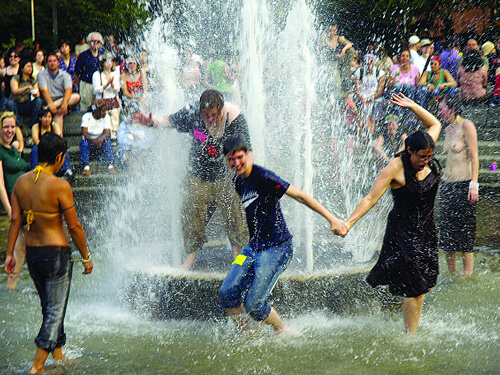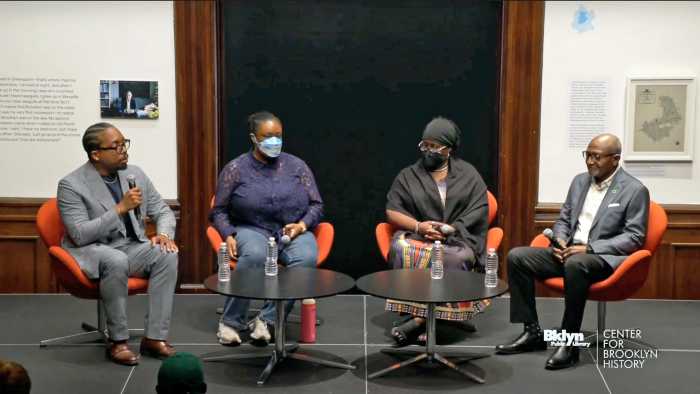Volume four, Issue 25 | June 30 – July 6, 2005
Pride
Dyke March Celebrates Difference
Disagreement, dissent never fully squelched, women nevertheless march in solidarity
Now in its 13th year, the annual Dyke March down Fifth Avenue from Bryant Park to Washington Square Park, held Saturday, June 25, eschews a police permit and marching regulations, while celebrating the many different ways that women-identified women love each other in New York’s lesbian community. (photo: Donna Aceto)
Every year for more than a decade, lesbians have gathered at Bryant Park in Midtown and stepped onto Fifth Avenue in a mass march for lesbian visibility, without police permits or extensive organizational structure.
This past Saturday, June 25, marked the 13th Annual Dyke March, boasting the motto “These Lesbians Don’t Run.” And, as diverse as is the lesbian community, so were views on the gains that have been made since this event began.
With the sun shining and thousands of out, loud and proud lesbian, bisexual and trans women filling the streets, the mood was far from somber. But from pioneering lesbians, now in their 60s and 70s, to young trans bois barely out of their teens, everyone seemed to have their own take on the state of lesbian visibility today.
Among the over-50 set, the sentiment was that stereotypes of lesbians remain more prevalent than realistic representations in mainstream American culture.
Vittoria Repetto, a chiropractor and poet, said, “I think we’re a little more visible than we used to be… but there’s still a lot of stereotypical perceptions, and ‘The L Word’ is not contributing to the breakdown of those stereotypes. I think it’s not so much the March [that’s changing things], but that people are living their lives the way they’re going to live their lives. You can march all you want, but you just got to every day be there and say, ‘This is who I am. You don’t like it, too bad.’”
March organizer and Lesbian Herstory Archives champion Maxine Wolfe added, “I think we’re visible in a lot of different ways than we were, like on TV, but I don’t think we’re really visible as the people we are. I think we have a lot more visibility in the stardom world, but in the everyday world, I don’t think so. And we shouldn’t trust that just because we’re on TV people love us. They still hate us.”
Tellingly, many lesbians referred to the Showtime series “The L Word” and other pop culture offerings as a barometer of lesbian visibility.
As the march moved from 42nd Street south toward the Flatiron Building, into Chelsea and the Village where it ended at Washington Square Park, some younger women said that it was precisely because of a rise in lesbian-themed shows, characters and musicians that visibility had been widened.
“I definitely think we’re more visible now,” said sex educator and performer Felice Shays. “I don’t want to give all the credit to the dykes that have outed themselves in the media, but that’s helped. But I also think that dyke culture is just becoming so vibrant, and there’s so many different scenes. I’m in fashion, so I get excited by all the different ways people express themselves in fashion and music, and there’s so much dyke music now, it’s beyond just the folk stuff. I think it’s a safer place to be out… I mean, if I can be out, and I’m an Iranian, Muslim, immigrant dyke, anyone can be out these days.”
“Definitely,” echoed Desi, host of the Dyke TV call-in program, “The Desi and Shiggy Show.” “You have even those candy/sugar shows like ‘The L Word,’ the march grows every year, gay and lesbian characters are being incorporated into the mainstream… I think it is better… but you can’t really rely on television programs, because television glamorizes everybody, straight or lesbian. Television is a fantasy world.”
Spoken-word performer Chris Hampton noted how the changes are not just in urban centers like New York City.
“I just came back from my high school reunion in Arkansas a couple of weeks ago, and even in a little town in Arkansas, there was a lesbian couple that owned a bar,” Hampton said. “It was definitely a culture shock being there compared to being here; there was not as much visibility, but I was surprised even there to find some visibility of the lesbians.”
But visibility is largely a matter of perspective, and as the queer community continues to evolve, some people remain on the outside. As she handed out stickers that read, “I support a Dyke March for the entire dyke community,” 28-year-old trans activist Shannon Blaney railed against the discrimination she felt upon discovering that FTM transmen were not welcomed by march organizers.
“In my professional life, I do research on health outcomes, and you can show social epidemiology statistics that identity-based discrimination does have a measurable impact on people’s health,” Blaney said. “It really pisses me off that this… discrimination is going on.”
Yet in the sort of defiance that has defined the entire struggle for LGBT rights, Blaney marched regardless of whether her personal ideals were supported or shared by the majority. This act spoke volumes about what the Dyke March means in terms of fighting for visibility.
For whether the community is railing against an unfriendly government or simply trying to convince each other to accept changing definitions of gender identity, lesbians can each year count on the Dyke March to be the perfect forum for expression and even disagreement.
gaycitynews.com

































